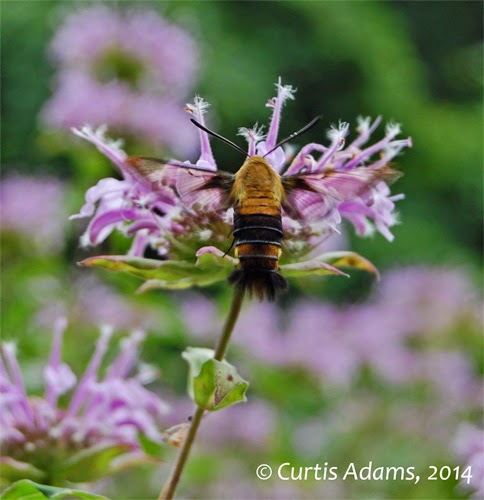As I have been walking around the property I have seen a
wide variety of insects. both good and bad.
Of course bad is based on the human perspective of what's eating the
plants that I am interested in either for food or aesthetics. The insect herbivores provide a link between
the solar energy stored up in plant materials and animals higher up in the food
chain. The really bad insects are those
that don't fit in with the food chain.
Those are the ones lacking a predator.
Here are a few of the interesting bugs that I encountered in
July.
 |
| This moth is about 1.5 inches long. |
Clymene Moth is said to be a common woodland species, though
I have seen it only this once. It is a
daytime flier so it should not be difficult to spot. The black cross on the tan wings certainly
stood out.
The larvae feed on a variety of plants, particularly Willows, Oaks and Eupatorium species.
The larvae feed on a variety of plants, particularly Willows, Oaks and Eupatorium species.
My wife spotted this Luna Moth while pulling out stiltgrass. I
think it had recently emerged from a cocoon because the wings appeared to be
very flexible. The large adult moths do
not feed. Their typical adult lifetime
is about a week. The larvae feed on
several species of trees, including hickories, persimmon and sumacs.
 |
| This moth was in a mass of stiltgrass |
 |
| We found this lethargic moth in early afternoon, these moths usually fly at night. |
 |
| Three of the 6 yellowish spots can be seen on the wing casings of this tiger beetle. |
The larval form is also predatory. It stays in a burrow and lunges out to capture passing small insects, like ants and spiders.
The largest of the leafhoppers at over 1/2 inch long is the Broad-headedSharpshooter, Oncometopia arbona. This
insect feeds on plant juices and shoots the liquid waste in an intense stream, hence
the name 'sharp-shooter'. It has the
overall shape of other leafhoppers, but it is much bigger. Leafhoppers
are vectors for a number of plant diseases.
This one can carry a bacteria that causes Pierce's disease in
grapes.
 |
| The jewel-like coloring of this insect caught my eye. It was tough to photograph because it kept scurrying to the opposite side of the cucumber from the camera. |
 |
| I only found this Mantis because it was moving, otherwise it would have blended into the grasses. At 4 inches, this is probably a Chinese Mantid. |
We saw one on the outside of our kitchen window that had
spotted a Japanese beetle on the inside.
It moved carefully into position and tried to grab the beetle through
the glass. After a couple of attempts I
squished the beetle and took it out of sight.
The mantis then just walked away into a nearby hanging basket.
I saw this green spotted beetle in the vegetable garden the other day and while I did not know
what is was, but I was pretty sure it was not something I wanted. My method of choice this season for dealing
with garden pests is squishing. So that's
what I did. It took quite a bit of force
to kill this beetle. (Cabbage moth caterpillars
are much easier to dispatch.) I got a
photo so that I could do an ID after the fact.
Turns out I made the right call.
This was a Spotted Cucumber Beetle.
These beetles feed on the leaves of cucumber and melon plants and can
spread bacterial wilt that will kill the entire vine.
 |
| These moths hover near flowers and gather nectar through their long proboscis. |
 |
| Hummingbird Moth at a Wild Bergamot, Monarda fistulosa. |
The larvae feed on honeysuckles, hawthorns and Prunus species. The pupae are found on the soil surface, or
over-wintering in the leaf litter.
My favorite garden predator is the Wheel Bug, Arilus cristatus. It is rather frightening in appearance in all
its growth stages. Like the mantis the wheel bug feeds on
a wide variety of insects, but I am especially happy when it gets a Japanese
beetle or a stink bug. They move slowly
to get close to their prey then grab hold and pierce them with their long
pointed beak. They inject enzymes to
dissolve the insides of their captive. While beneficial in
the garden, they can inflict a painful
'bite' to humans if they are threatened with no clear escape.
 |
| Evening Primrose, Oenothera biennis, is a favorite of Japanese Beetles. It is also a good place to find Wheel Bugs. You can see the dark beak sticking into the beetle. |







No comments:
Post a Comment